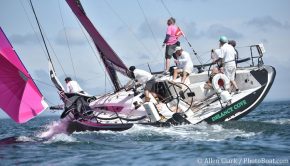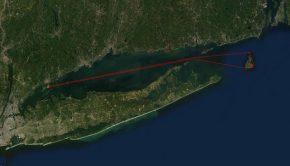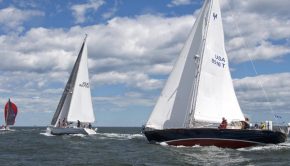When abandonment is a good feeling
Published on June 3rd, 2021
As the first major regional distance race of the year, Storm Trysail Club’s Block Island Race on Long Island Sound has been having a hard time completing its 75th edition. After the pandemic cancelled the 2020 attempt, Mother Nature thwarted the do-over this year.
Starting and finishing off of Stamford Harbor, ORC and PHRF classes were to sail either the Block Island Course (186 nm) or the Plum Island Course (125 nm). But with nearly 50 boats signed up for the May 28 start, an ornery forecast led to the cancellation. Tim Zimmermann provides the report:
The Block Island Race—which starts in Stamford, CT and sails the length of Long Island Sound, out around Block Island and then back to Stamford—was going to be one of my summer racing highlights after the cancellation of the 2021 Marion-Bermuda Race (COVID navigation problems—same as the 2020 Newport-Bermuda Race which also canceled).
I was going to sail with Steve, a friend going back to college, and his always enjoyable crew. And we were going to sail on his tricked-out Swan 44 MKII, a boat which, under its former owner, raced Sydney-Hobart, the Fastnet, and the Middle Sea Race, to name just a few, um, minor regattas. Sounds good, right?
Naturally, I started watching the weather forecasts about a week out. Long-range models predicted cooler temps and moderate easterlies. But by three days before the Friday start, a complex series of lows and a blocking high started to turn the Windy screen from green, to yellow, to orange, to red. With rain. And temps in the 40s and 50s.
The GFS model looked ugliest, so I clung to the Euro model, which had the lows sliding offshore, resulting in more moderate conditions. But reality set in when I listened in to a weather briefing call by Ken Campbell of Commander’s Weather on Thursday morning (May 27), as I drove north.
Campbell explained that we were basically looking at a winter weather pattern, when coastal lows and strong northeasterlies commonly pound the Atlantic coast. He warned that the highest winds would occur when the fleet was most exposed in Block Island Sound, that wind chills would be in the 30s, and that we might see short 10-foot waves exiting Long Island Sound, where the highest tides of the year would be ebbing hard against the strong easterlies.
“In the 30 years I have been doing this, I’ve seen worse,” he said. “But this looks pretty bad.” For good measure he signed off with a wry “I’m glad I won’t be out there.” Alrighty then.
Steve and the rest of The Rover crew sail for fun, not for ego and not for masochism credits. The Swan 44 could probably take just about anything. But it would be a pretty miserable experience.
We discussed opting for the shorter Plum Island course, which would at least keep us in the Sound. By Thursday afternoon the Storm Trysail Race Committee agreed, and indicated that it would shorten the course to Plum Island. That seemed quite sensible. But it still meant dealing with gale force winds in eastern Long Island Sound, and a horrific sea state.
On Friday morning, Ken Campbell wasn’t any more optimistic. If anything, the forecast had worsened, with winds potentially gusting up to 50.
During questions, a Storm Trysail Race Committee member asked Campbell to show us what the Plum Island rounding would look like around 2 am Saturday morning, when most of the fleet would be in the vicinity. Deep purples filled the screen.
Right there and then I started to think there was a pretty good chance the Race Committee would abandon. We headed to breakfast to contemplate our fate. While we were tucking away egg sandwiches and burritos, I checked the online RC Notice Board. Race abandoned:
————–
The Storm Trysail Club Race Committee of the 75th Block Island Race has been evaluating forecast weather conditions very closely and with the help of a number of weather consultants. We have to expect that if we proceed, the fleet will experience sustained winds of 30 to 35 knots and gusts over 40 in the 0100 to 0500 period Saturday morning. In addition, there will be an unusually strong ebb current against the wind until 0130, cold water and air temperatures, and heavy rain. We do not feel it is prudent to start the race under these circumstances.
Forecasts suggest that strong winds and rain will persist into the day Saturday and the sea-state in western Long Island Sound will be bad through the day on Saturday.
Regretfully we are posting “N” over “A” all races abandoned.
————–
That must have been a very tough call. While it sort of felt like the firing squad had suddenly been disbanded, I also wondered whether the RC might have been able to postpone the start until Saturday noon, when the conditions would still be horrible, but totally sailable.
In fact, on Thursday evening, during after we had been given our Yellowbrick tracker at the Stamford Yacht Club, I said “Thanks, now where do we go to lobby the Race Committee to postpone the start until Saturday noon.” “I am on the Race Committee,” a friendly guy replied. “But we can only postpone the start to 8 am Saturday, when conditions would still be pretty bad.”
I wasn’t sure why the postponement would be limited to 8 am, but appreciated the answer. After the race had been abandoned, the same gentleman was at the club when we returned the Yellowbrick tracker. Curious, I asked him about the decision to abandon, saying “Thirty years ago I can imagine a Race Committee might have simply proceeded with the race and left it up to skippers to decide whether to sail.”
“Well, he responded. “I have actually been doing this for thirty years, and the big difference is that today we have much better information on what the weather will be.” I hadn’t considered that point, and it is a good one.
It is one thing to send a fleet out when there is uncertainty about how bad the weather will be. It is quite another to do the same thing when you know that the weather could be dangerous. He added an additional consideration. “We know our fleet,” he told me. “And there are a lot of new COVID boat owners, and crews that are not that experienced signed up for the race. In these conditions someone would get hurt.”
In short, he finished, to send the fleet out in conditions that had even Ken Campbell shaking his head “would have been irresponsible.”
That was a thoroughly complete and satisfactory answer, and much appreciated. These can be difficult judgement calls for an organizing authority. But in this case a confluence of perfectly aligned factors—max wind at the most exposed section of the course; max tidal flows, and severe wind chill danger—perhaps made the choice less difficult.
I was disappointed not to be racing, but as I left Stamford Yacht Club I felt confident the Race Committee had made the right decision.
That was confirmed when on Friday just after the race was called we delivered The Rover back to its home port of Westbrook though building winds and seas. By the time we pulled in to Pilots Point Marina I was chilled to the bone and very happy to be headed for a warm shower and relaxing dinner.
Race Committees get a lot of grief, but the Storm Trysail Club had thought it all through carefully. And sometimes that feeling of abandonment is a pretty good feeling.









 We’ll keep your information safe.
We’ll keep your information safe.